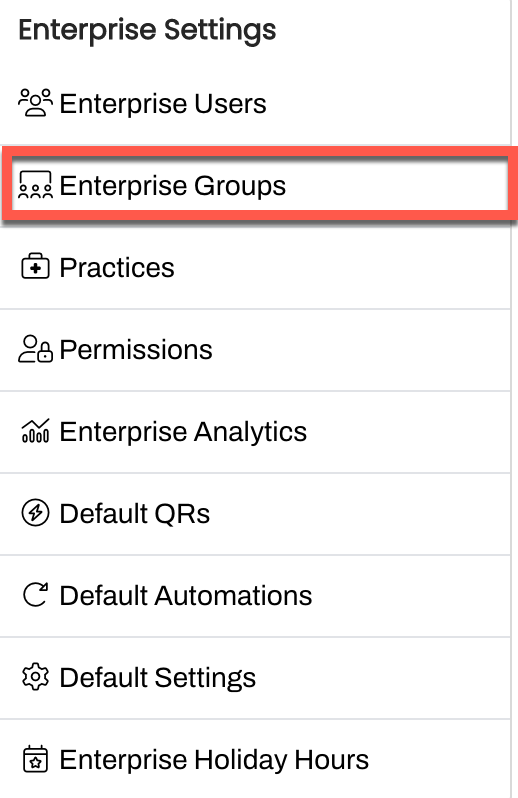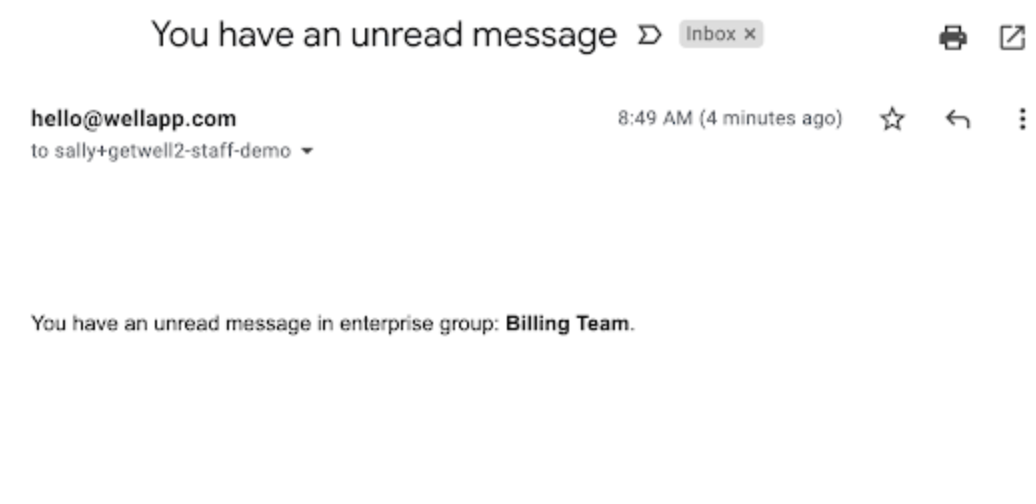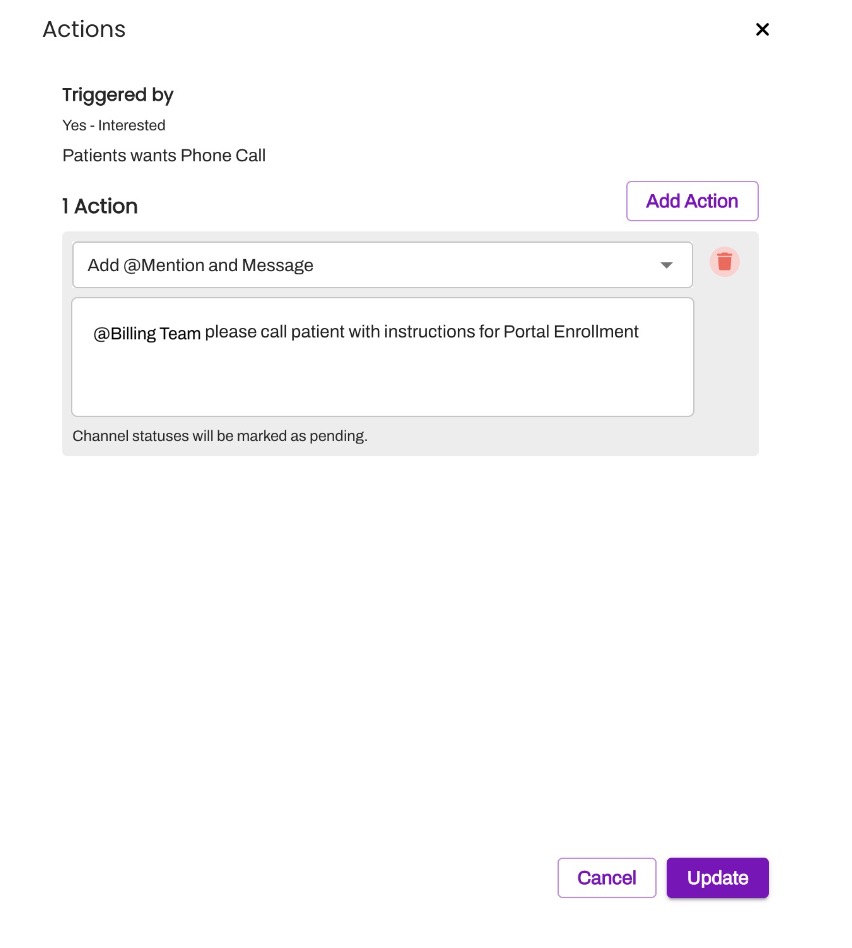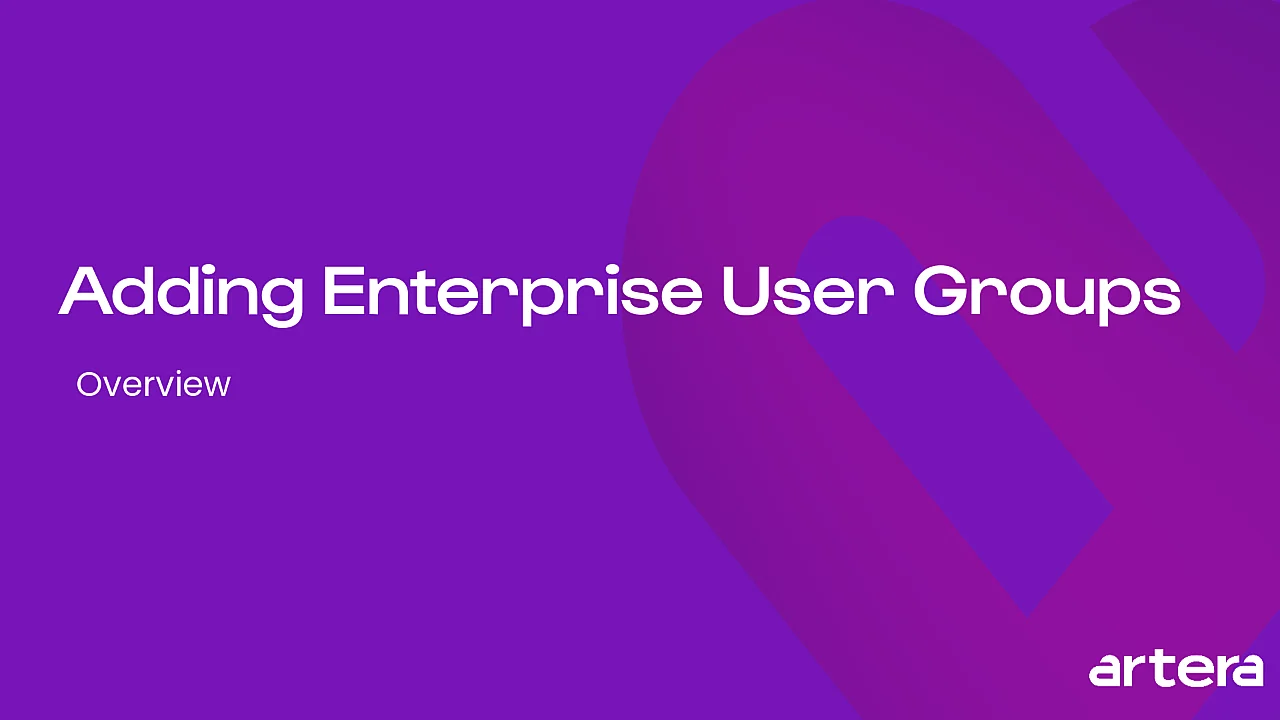Enterprise User Groups
- Get Started
- Release Notes
- Triggers
- Patient Channel
- Troubleshooting and FAQ
- Patient Facesheet
- Technical Specifications
- Insights & Analytics
- Inbox
- Conversation Flows
- Campaigns
- Lines & Resources Requests
- Lines, Events, Resources
- SMS Basics
- Automations
- Referrals
- AI Agents
- Add-Ons
- Users and Groups
- Platform Settings and Configuration
- Self-Rescheduling
- Recalls
- Marketplace
- Artera Harmony Federal Edition
Table of Contents
Create an Enterprise User Group Edit/Disable an Enterprise User Group Mentioning and AlertsViewing your Internal MentionsMentions ReportingUser Groups and Enterprise User Groups allow you to tag relevant groups of users using the Internal Mentions functionality in Patient Channels. These two types of User Groups have slightly different functionality:
This article discusses Enterprise User Groups. Click here to learn about User Groups.
Video Tutorial
Create an Enterprise User Group
-
Open the Settings menu.

- Navigate to Enterprise Settings > Enterprise Groups.

- In the upper-right corner of the page, select + Add New Enterprise Group.
- Add a Name and Description. The name of the Enterprise User Group is important as this is what will be used to tag the group in an Internal Mention. NOTE: Each Enterprise User Group must be configured with a unique name.

-
Use the Practices drop-down to select the Practice(s) that can mention this Enterprise User Group.
- You must choose at least one Practice or the Enterprise User Group will not be available for use.

- You must choose at least one Practice or the Enterprise User Group will not be available for use.
- Search for users that should receive the Internal Mention when the Enterprise Group is tagged. These can be Staff, Manager, or Enterprise Users. The users do not need to have access to the Practice where they are mentioned. Being part of the Enterprise User Group temporarily grants the users access to the Patient Channel to resolve the Internal Mention.

-
Notification Preference: You can opt the user into receiving a text or email notification when the Internal Mention is created. When ready, click Save. NOTE: Ensure users who have "text" selected for communication preference have a mobile phone number in their Artera user profile.
- Text

-
Email

- Text
- Resolving an Internal Mention will not send another alert to the Enterprise User Group indicating the task has been completed.

- Edit: You can edit the Enterprise User Group's details including name, membership, notification options, and Practice availability. Use the (...) menu to select Edit Enterprise User Group.
- Disable: You can disable the Enterprise User Group to prevent it from being mentioned in a Patient Channel. Use the (...) menu to select Disable Enterprise User Group. NOTE: Enterprise User Groups cannot be deleted, only disabled.
Mentioning and Alerts
Let's review how to mention Enterprise User Groups, resolve Internal Mention alerts, and Internal Mentions Reporting.
Mentioning Enterprise User Groups
-
Patient Channel: Enterprise User Groups can be mentioned directly from the Patient Channel using the @Mention tab and inserting the "@" symbol followed by the the name of the Enterprise User Group. NOTE: The Enterprise User Group is only available for use within the Practice(s) selected during its configuration.

-
Inbound Message Triggers: Enterprise User Groups can also be mentioned as an action from an Inbound Message Trigger. NOTE: The Enterprise User Group is only available for use within the Practice(s) selected during its configuration.

-
Conversation Flows: You can set up an Add @Mention and Message Action within a Conversation Flow that will mention an Enterprise User Group.

Viewing Your Internal Mentions
Access your Internal Mentions from all views within the Inbox.
"Activity" View
The "Activity" view provides a complete overview of your Internal Mentions, both direct (@ Me) and User Group (@ Groups) mentions. It displays your unresolved and resolved Internal Mentions, including a total count of your unresolved Internal Mentions in the navigation bar. This number updates dynamically as new Internal Mentions are created for you or existing ones are resolved.
NOTE: The "Activity" View only displays Internal Mentions where you are the user tagged. It does not display the Internal Mentions that you created for other users. 
By default, the "Activity" view displays your direct, unresolved Internal Mentions in the @ Me tab. This is your immediate to-do list for managing your direct Internal Mentions.

To view your unresolved User Group mentions, select the @ Groups tab from this view. This displays all Internal Mentions where a User Group you are a member of has been tagged.

Each Internal Mention card displays the Practice the Internal Mention was added in, the user who created the Internal Mention, the line associated with the Internal Mention, and up to a two-line message preview (if a message was included by the creator of the Internal Mention).

As soon as an Internal Mention is resolved, it will automatically move from the "Unresolved" section to the "Resolved" section in this view.
NOTE: Resolved Internal Mentions display for the past 30 days.
Filtering for Internal Mentions
Use the Filters Panel in the "All Messages" and "Scheduled" views to filter for "@ Internal Mentions".

Once the Internal Mention is worked/resolved, the Enterprise User Group member can update the Channel Status to Resolve Mentions. This automatically resolves the alert for all the Enterprise User Group's members. NOTE: Resolving the Mention will not send an alert to the Enterprise User Group indicating the task has been completed.

Mentions Reporting
Enterprise User Groups can be mentioned from all Practices within an Enterprise that are selected when creating the Enterprise User Group. Although the Enterprise User Group can contain multiple users, Enterprise User Groups are counted as one single user within the context of "Mentions Reporting" in analytics. Therefore, using Enterprise User Groups may impact the accuracy of Mentions reports which track the number of unique senders, as the Enterprise User Group itself is one unique sender, regardless of its member count.
